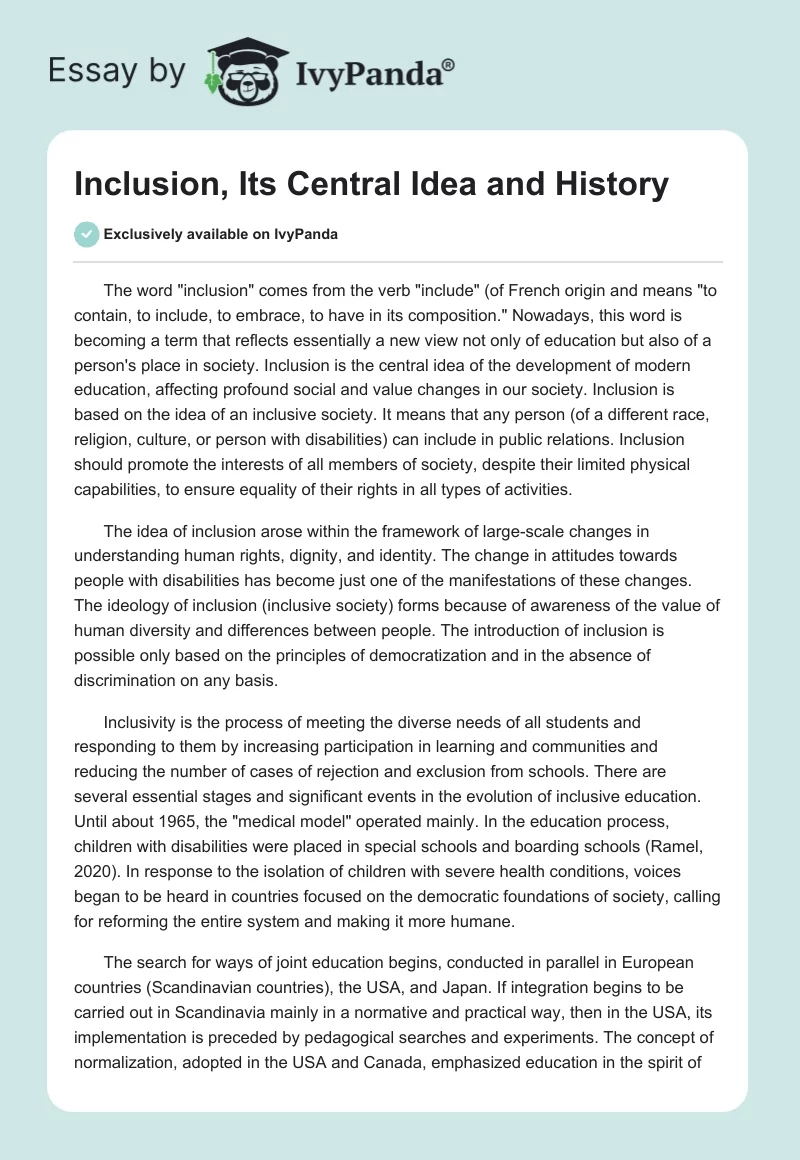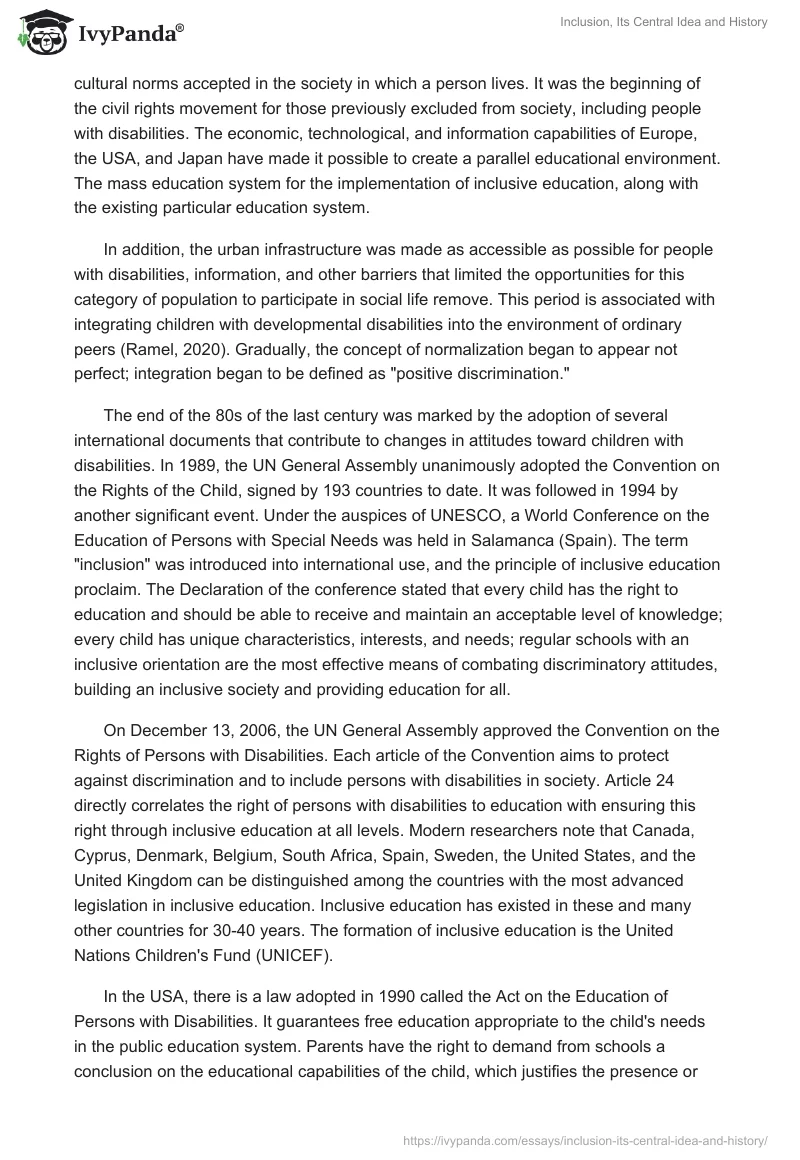The word “inclusion” comes from the verb “include” (of French origin and means “to contain, to include, to embrace, to have in its composition.” Nowadays, this word is becoming a term that reflects essentially a new view not only of education but also of a person’s place in society. Inclusion is the central idea of the development of modern education, affecting profound social and value changes in our society. Inclusion is based on the idea of an inclusive society. It means that any person (of a different race, religion, culture, or person with disabilities) can include in public relations. Inclusion should promote the interests of all members of society, despite their limited physical capabilities, to ensure equality of their rights in all types of activities.
The idea of inclusion arose within the framework of large-scale changes in understanding human rights, dignity, and identity. The change in attitudes towards people with disabilities has become just one of the manifestations of these changes. The ideology of inclusion (inclusive society) forms because of awareness of the value of human diversity and differences between people. The introduction of inclusion is possible only based on the principles of democratization and in the absence of discrimination on any basis.
Inclusivity is the process of meeting the diverse needs of all students and responding to them by increasing participation in learning and communities and reducing the number of cases of rejection and exclusion from schools. There are several essential stages and significant events in the evolution of inclusive education. Until about 1965, the “medical model” operated mainly. In the education process, children with disabilities were placed in special schools and boarding schools (Ramel, 2020). In response to the isolation of children with severe health conditions, voices began to be heard in countries focused on the democratic foundations of society, calling for reforming the entire system and making it more humane.
The search for ways of joint education begins, conducted in parallel in European countries (Scandinavian countries), the USA, and Japan. If integration begins to be carried out in Scandinavia mainly in a normative and practical way, then in the USA, its implementation is preceded by pedagogical searches and experiments. The concept of normalization, adopted in the USA and Canada, emphasized education in the spirit of cultural norms accepted in the society in which a person lives. It was the beginning of the civil rights movement for those previously excluded from society, including people with disabilities. The economic, technological, and information capabilities of Europe, the USA, and Japan have made it possible to create a parallel educational environment. The mass education system for the implementation of inclusive education, along with the existing particular education system.
In addition, the urban infrastructure was made as accessible as possible for people with disabilities, information, and other barriers that limited the opportunities for this category of population to participate in social life remove. This period is associated with integrating children with developmental disabilities into the environment of ordinary peers (Ramel, 2020). Gradually, the concept of normalization began to appear not perfect; integration began to be defined as “positive discrimination.”
The end of the 80s of the last century was marked by the adoption of several international documents that contribute to changes in attitudes toward children with disabilities. In 1989, the UN General Assembly unanimously adopted the Convention on the Rights of the Child, signed by 193 countries to date. It was followed in 1994 by another significant event. Under the auspices of UNESCO, a World Conference on the Education of Persons with Special Needs was held in Salamanca (Spain). The term “inclusion” was introduced into international use, and the principle of inclusive education proclaim. The Declaration of the conference stated that every child has the right to education and should be able to receive and maintain an acceptable level of knowledge; every child has unique characteristics, interests, and needs; regular schools with an inclusive orientation are the most effective means of combating discriminatory attitudes, building an inclusive society and providing education for all.
On December 13, 2006, the UN General Assembly approved the Convention on the Rights of Persons with Disabilities. Each article of the Convention aims to protect against discrimination and to include persons with disabilities in society. Article 24 directly correlates the right of persons with disabilities to education with ensuring this right through inclusive education at all levels. Modern researchers note that Canada, Cyprus, Denmark, Belgium, South Africa, Spain, Sweden, the United States, and the United Kingdom can be distinguished among the countries with the most advanced legislation in inclusive education. Inclusive education has existed in these and many other countries for 30-40 years. The formation of inclusive education is the United Nations Children’s Fund (UNICEF).
In the USA, there is a law adopted in 1990 called the Act on the Education of Persons with Disabilities. It guarantees free education appropriate to the child’s needs in the public education system. Parents have the right to demand from schools a conclusion on the educational capabilities of the child, which justifies the presence or absence of developmental disorders in the child. Exceptional standards have been developed in Europe for making information easy to read and understand. Inclusive education has the ultimate goal of creating an inclusive society that will allow all children and adults, regardless of gender, age, and ethnicity, to participate in and contribute to the life of society.
Reference
Ramel, S. (2020). Foreword: inclusion education: A burning issue for researchers around the World. Journal of Studies in Language, Culture and Society (JSLCS), 3(2), 1-2.


